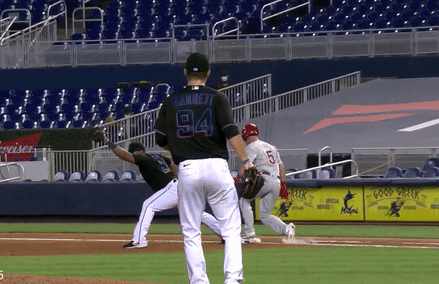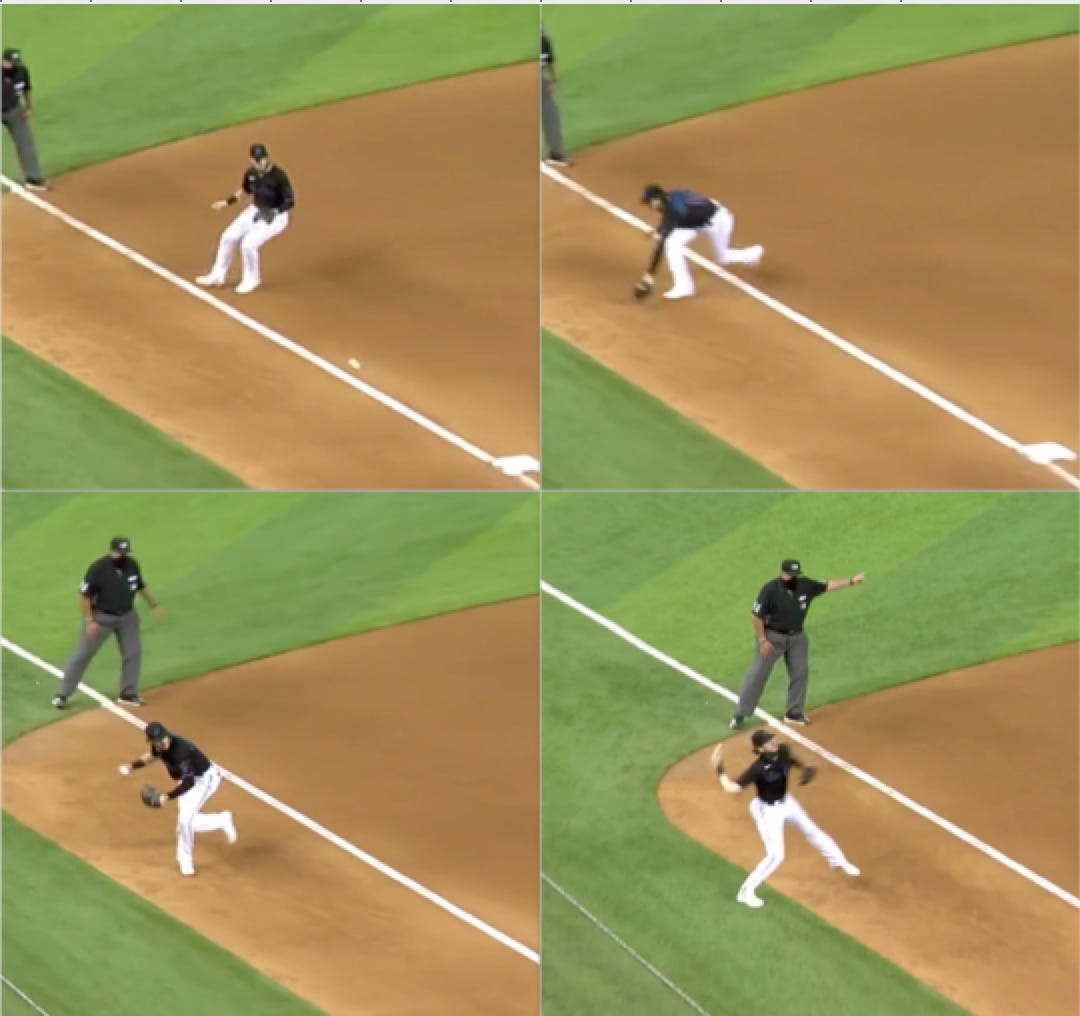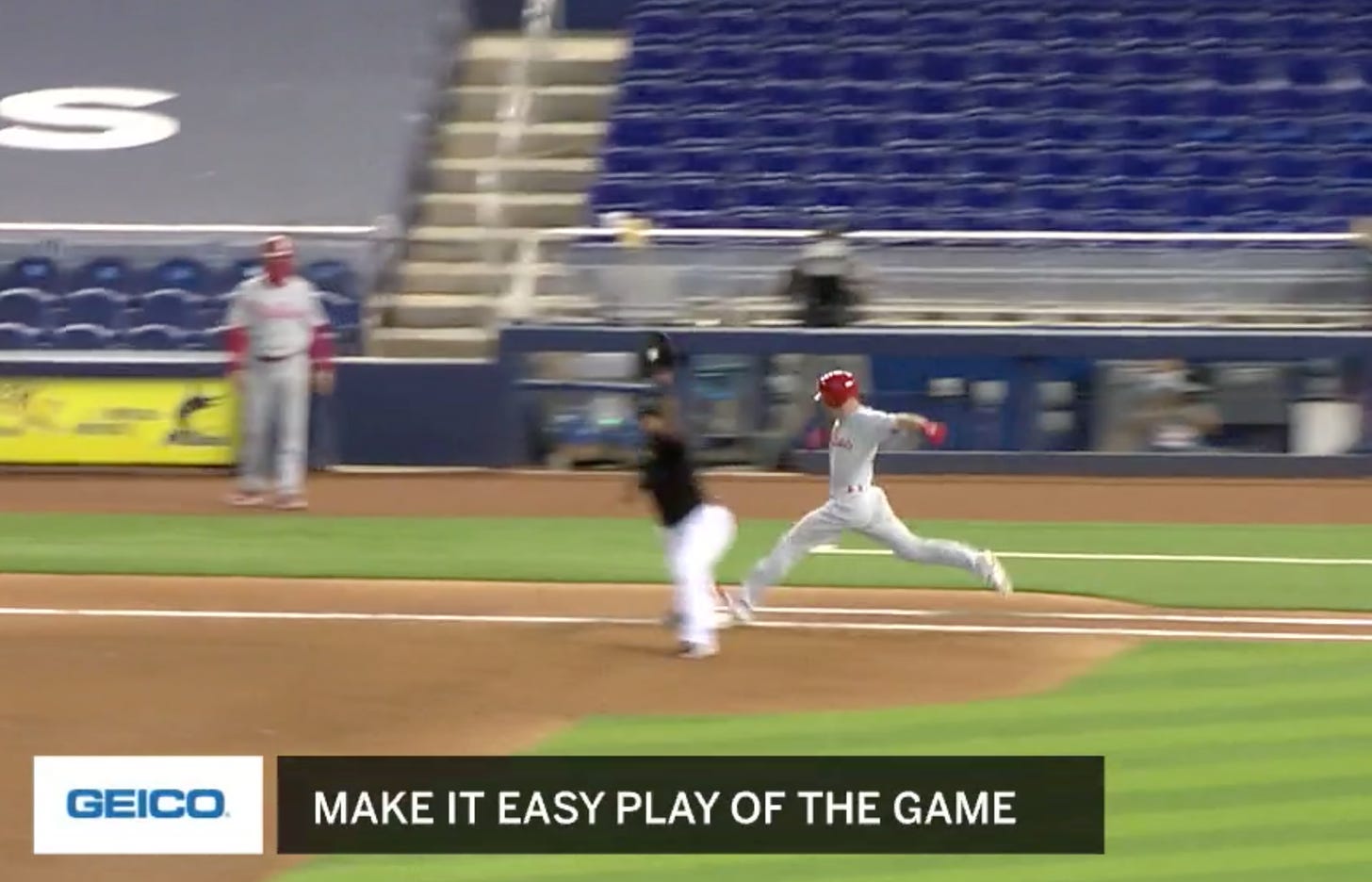I have seen three plays this year that were immediately labeled, by some, The Play Of The Year:
Hunter Renfroe, on Opening Day, got turned around while retreating for a fly ball. With his back to the rest of the field, he flung his glove up and out, blindly, desperately, while jumping, and caught the ball. Some catch!
Bobby Witt Jr., a few days later, raced out from shortstop on a ball hit to shallow left-center. Witt, tracking the ball over his shoulder, traveled a great distance before diving to catch the ball. Radiant!
Aaron Judge, playing in hyped-up showdown against Shohei Othani, was in center field when Ohtani hit a ball just over the top of the wall. Judge timed his jump, gloved the ball to save a home run, then fumbled the ball but, as he landed, secured it with his bare hand for an out. Terrific!
These are very different catches. Witt had a plan and he executed it perfectly. Renfroe was as far from a plan as a fielder can be, and he somehow executed that perfectly. Judge had a plan, mostly executed it, but when things got bobbly he adapted, perfectly. Which one you’d consider to be the play of the year is, obviously, a matter of taste, but matters of taste are usually defined by some broader values.
I’m going to take a zag here. I want to talk about the play from the past decade that most stuck with me, that I would probably call my favorite defensive highlight of the recent past. “What’ve you been up to?” people would ask me last year, and I’d say Oh, mostly just thinking about an 82 mph groundball Andrew Knapp hit to Brian Anderson back in 2020. The ball hit the third-base bag, things got weird, and Anderson did this:
Remember this play? Probably not! Using the common metrics, it was nothing special: According to Statcast—which doesn’t flag the ball hitting the base— this was only 7 percent likely to be a hit. Defensive Runs Saved also doesn’t know this hit the bag, so credited Anderson with 0.23 runs saved on a 78 percent out probability. When MLB.com compiled the 100 Plays of the Year, the Brian Anderson play didn’t crack it. But I couldn’t believe what I’d seen, and neither could Marlins pitcher Braxton Garrett:
And this is where my theory of highlights (and perhaps Braxton Garrett’s theory of highlights) comes in:
It’s Improvisation That Makes Great Highlights
When a ball hits a base, it can go anywhere; the base is not flush or flat, it has corners and it can send a previously predictable groundball into another dimension. Because of that, these can’t be rehearsed, prepared for, anticipated. They are so off-script that when Martin Prado whiffed on this base-redirected ball his instinctive reaction was to look to the umpire for a that’s-no-fair, do-over call. When Justin Turner went to field a groundball that was quite similar to the one Anderson fielded—but also, of course, quite different, because balls hitting bases produce entirely unique circumstances—he was helpless, even though the ball redirected just a few inches. Baseball players are fundamentally fast-reactors—that’s their signature skill, reacting to fast pitches and reacting quickly to batted balls—but those reactions are trained by repetition. When a ball hits a bag and spits off in literally any direction, these fielders have been robbed of all their training and become cognitively naked.
In Anderson’s case, the unpredictable hop also turned the rest of the play into a sequence of unpracticed physical demands. Anderson had already halted his rightward momentum when the ball was descending for the final hop. He was leaning his weight back slightly, away from the foul line. He expected a predictable bounce toward the middle of his body. When the ball skipped in a different direction, low and away from his center of gravity, he had to suddenly stab down and back, a move that I simply can’t replicate with my body. When I try—knowing what I’m going to be doing, unlike Anderson—my left hip collapses and I tumble; if I try to mentally prepare for that, my right ankle crumples, and I roll over. If I manage to steel my ankle, I feel pressure shooting through both knees. I am not an elite athlete, obviously. Brian Anderson is. He moved from a slight squat into a low lunge on the extreme opposite side of his body, with no chance to anticipate and shift his balance, in the time it took a quick-moving ball to travel six feet. Then, before he had taken even a single step to steady himself, he had already planted one foot at an ankle-turning angle on which to spin his body around and throw. It took him two steps not to recover some basic level of control over his body and keep from falling (which would be something!) but to fully gather his strength, turn and throw. This all took 1.1 seconds:
And the throw! Because the ball took him into foul territory, he had to pivot and throw while running in the opposite direction of his target. Which, not surprisingly, created issues. Where could he plant for this throw? On a right foot that was grounded for all of 0.2 seconds. From what angle could he make this heave? From, it turned out, a throwing position that looks sketched by a 7-year-old trying to draw his first baseball player.
On top of this, Anderson was in such a rush that he had to shovel the ball from his glove into his throwing hand, so he ended up with a changeup-like grip. As he spun and planted and found his target he also made whatever subconscious adjustment he had to make to accommodate this unusual grip, and he threw hard and accurately. This is how close the play ended up being:
Say it again, Braxton.
The Greater The Improvisation, The Greater The Highlight
Most good plays are pretty predictable. When you think of a typical defensive highlight (sliding catch, diving stop) you think of a demonstration of athletic skill (run fast, jump high, throw hard) in a chance that is conveniently right at the edge of a player’s range. Conveniently is the key. An outfielder who can run 85 feet before a given fly ball descends has produced a good highlight only if the ball is hit 85 feet away from him; if it’s hit 83 feet away from him then that’s a weak highlight, and if it’s hit 87 feet away from him it’s no catch/no highlight. Meanwhile, an outfielder who can run 95 feet (a superior demonstration of athletic skill!) could catch even the 87-foot ball but would produce no highlight at all; he’d be camped out underneath it. Thought of this way, most good plays—which are fun; they’re difficult little short stories that resolve some uncertainty—are just about confirming that a player has some limit to his range. Highlights are the visually pleasing record of where those limits are.
Some plays, though, unexpectedly turn into something unpredictable, and this is when the player has to improvise. A great catch becomes transcendent with the introduction of a tarp. A great charging play becomes transcendent when the shortstop is forced to invent a new arm angle from which to throw. The greatest highlight by the greatest defensive shortstop was produced by a bad hop. The most replayed defensive highlight of my childhood was Kevin Mitchell’s improvised bare-handed catch on an otherwise routine play; the most replayed highlight of my early adulthood was Derek Jeter’s improvised flip play, which (relative to most highlights) was not really about athleticism, so much as about improvised precision under novel circumstances.
All of those plays were extraordinary because they were never practiced. The fielders all had to get them right at game-speed on the very first try. Their brains had to invent, their bodies had to move in strange ways, and in succeeding they demonstrated not where their limits are but that their limits couldn’t be found. Throw anything at them; they’ll figure something out.
Keep reading with a 7-day free trial
Subscribe to Pebble Hunting to keep reading this post and get 7 days of free access to the full post archives.







